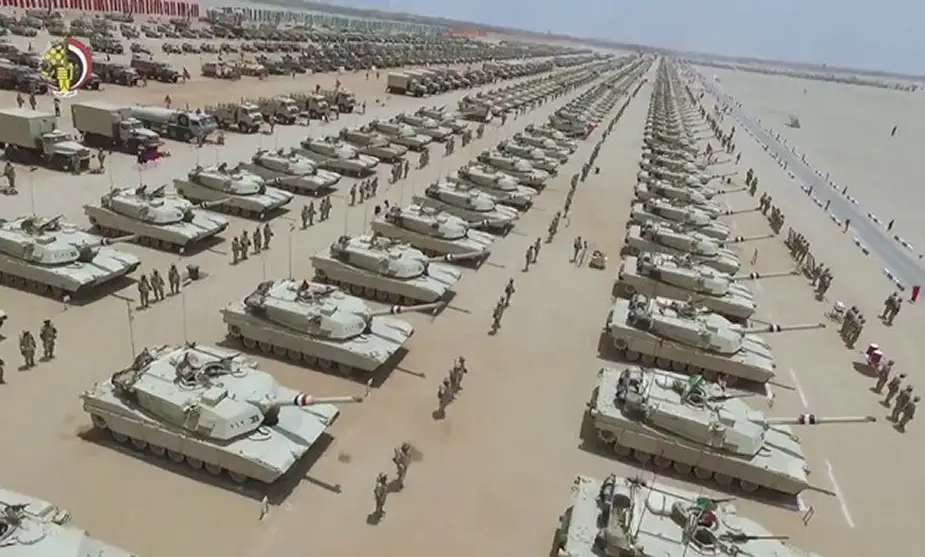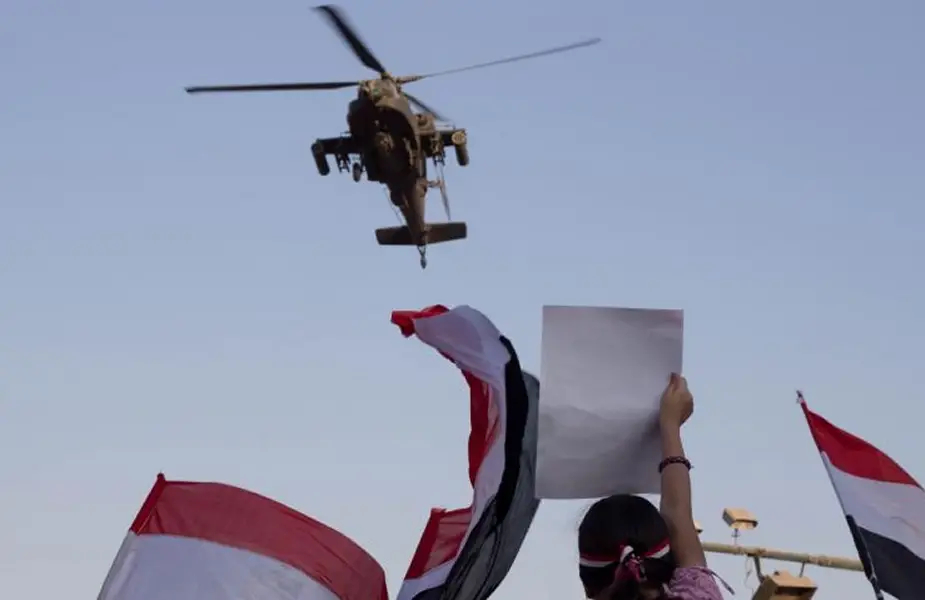As reported by Defense News Nigeria, Africa's most powerful army - the Egyptian one - is amassing tanks and helicopter gunships at the Libyan border: M1A2 Abrams main battle tanks and AH-64E Apache attack helicopters appear more and more numerous, ready to retaliate to “provocations” from Marshal Khalifa Haftar’s Tobruk-based Libyan National Army (LNA).
Follow Army Recognition on Google News at this link

Egyptian army display with M1A2 Abrams MBTs in the foreground (Picture source: Egyptian TV via Twitter account of Defense News Nigeria)
This deployment of forces announces an Egyptian intervention against Marshal Khalifa Haftar’s Tobruk-based Libyan National Army (LNA). The Second Libyan Civil War is an ongoing conflict among rival factions seeking control of Libya. After erupting in 2014, the conflict is mostly between:
* the House of Representatives, elected in 2014 with a low turnout (18%), relocated to Tobruk, which appointed Marshal Khalifa Haftar as commander-in-chief of the Libyan National Army with the mission of restoring its sovereignty over the whole of Libyan territory;
* the Government of National Accord, led by Prime Minister Fayez al-Sarraj, based in the capital Tripoli and established after failed military coups and the relocation of the House of Representatives to Tobruk. It is recognized by the UN as the sole legal government of Libya.
Turkey, Russia, Qatar and several other countries each support one of the two rival factions, which means a worsening conflict for the months (and years?) to come.
Egyptian AH-64E Apache attack helicopters
The current Egyptian deployment of forces at the Libyan border takes place as the U.S. State Department recently approved a possible Foreign Military Sale of a refurbishment package for 43 Boeing AH-64E Apache attack helicopters owned by Egypt. The estimated $2.3 billion deal is not final but was announced via a required notification by the Defense Security Cooperation Agency to the U.S. Congress on 7 May. As part of the refurbishment package, Egypt would receive 88 GE Aviation T700-GE-701D turboshaft engines; 47 Lockheed Martin Modernized Target Acquisition Designation Sight/Pilot Night Vision Sensors; 45 BAE Systems’ Common Missile Warning Systems; and 92 Honeywell Embedded Global Positioning System/Inertial Navigation Systems, among other electronics upgrades and spare parts. Many of the components, including most of the T700 turboshaft engines, would be remanufactured. The deal would also come with weapons: Hellfire missile launchers, 2.75in tube rocket launchers, and M230 chain guns.
“Egypt intends to use these refurbished AH-64 helicopters to modernize its armed forces to address the shared US-Egyptian interest in countering terrorist activities emanating from the Sinai Peninsula, which threaten Egyptian and Israeli security and undermine regional stability,” says the Defense Security Cooperation Agency. However, these Apaches seem about see action elsewhere than the Sinai.

Egyptian Boeing AH-64E Apache (Picture source: Twitter account of Defense News Nigeria)
Egyptian M1A2 Abrams MBTs
The program and the plan for the construction of the co-production facility were advanced by Field Marshal Abd al-Halim Abu Ghazala as a way for Egypt to save money on the procurement of M1 Abrams main battle tanks while concurrently developing its own defense industrial base. Initially, the plan was estimated to eventually shift 40% of the tank's production to Egypt to save money by taking advantage of the low cost of Egyptian labor. These savings would be realized over the course of a decade-long production run of 1,500 tanks, as well as the eventual use of the factory to produce other kinds of vehicles and serve as a repair depot for Egypt's fleet of M60 Patton main battle tanks. In 1984, Egypt signed a US$150 million contract with General Dynamics for the construction of the factory, which was financed using American security assistance funds and portions of Egypt's annual US$1.3 billion in foreign military financing.
Starting production in 1988, the factory soon experienced numerous cost overruns, inflating the price of each tank to a level beyond the cost of buying complete tanks—the initial production run was estimated to cost US$2.7 billion versus US$1.9 billion for purchasing tanks directly from the United States via General Dynamics. Egyptian defense officials believed these additional costs were of no concern, stating that the factory "...serves other Egyptian goals such as economic development, modernization of the tank fleet, self-sufficiency in tank production...". However, in a review of the program, the General Accounting Office (now the Government Accountability Office) noted that Egypt's purported gains in self-sufficiency were limited because the United States, citing security issues, would not part with key pieces of technology needed to manufacture the bulk of the tank's components, including the armor, fire-control system, and engine.[6] Egyptian input in the production process was originally planned increase over the course of six phases, with later phases including the transfer of technologies needed to manufacture more advanced portions of the vehicle; however, the cost increases and the lack of technology transfers eventually halted the advancement of these phases, leaving the factory in a position where it only had the capability to produce the simplest parts of the tank and had to acquire all other parts from US-based companies. As a consequence, American officials estimated that Egypt would only be able to indigenously produce 19% of the tank's parts.
To date, the co-production program has yielded approximately 1,130 Abrams tanks. The shipment of additional tank kits to the factory was suspended, along with the transfer of other military vehicles, in response to the Egyptian military's crackdown of Muslim Brotherhood supporters following the removal of Mohamed Morsi from power. In addition to assembling tanks, the co-production facility also produces construction vehicles intended for the commercial market.














